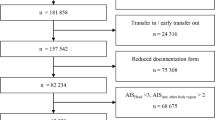Abstract
Introduction
Since progressive hemorrhagic injury (PHI) was introduced in neurosurgical literatures, several studies have been performed, the results of which have influenced doctors but do not define guidelines for the best treatment of PHI. PHI may be confirmed by a serial computerized tomography (CT) scan, and it has been shown to be associated with a fivefold increase in the risk of clinical worsening and is a significant cause of morbidity and mortality as well. So, early detection of PHI is practically important in a clinical situation.
Methods
To analyze the early CT signs of progressive hemorrhagic injury following acute traumatic brain injury (TBI) and explore their clinical significances, PHI was confirmed by comparing the first and repeated CT scans. Data were analyzed and compared including times from injury to the first CT and signs of the early CT scan. Logistic regression analysis was used to show the risk factors related to PHI.
Results
A cohort of 630 TBI patients was evaluated, and there were 189 (30%) patients who suffered from PHI. For patients with their first CT scan obtained as early as 2 h post-injury, there were 116 (77.25%) cases who suffered from PHI. The differences between PHIs and non-PHIs were significant in the initial CT scans showing fracture, subarachnoid hemorrhage (SAH), brain contusion, epidural hematoma (EDH), subdural hematoma (SDH), and multiple hematoma as well as the times from injury to the first CT scan (P < 0.01). Logistic regression analysis showed that early CT scans (EDH, SDH, SAH, fracture, and brain contusion) were predictors of PHI (P < 0.01).
Conclusion
For patients with the first CT scan obtained as early as 2 h post-injury, a follow-up CT scan should be performed promptly. If the initial CT scan shows SAH, brain contusion, and primary hematoma with brain swelling, an earlier and dynamic CT scan should be performed for detection of PHI as early as possible and the medical intervention would be enforced in time.



Similar content being viewed by others
References
Klauber MR, Marshall LF, Toole BM et al (1985) Cause of decline in head-injury mortality rate in San Diego County, California. J Neurosurg 62:528–531
Shackford SR, Mackersie RC, Hoyt DB et al (1987) Impact of a trauma system on outcome of severely injured patients. Arch Surg 122:523–527
Perel P, Roberts I, Bouamra O et al (2009) Intracranial bleeding in patients with traumatic brain injury: a prognostic study. BMC Emerg Med 9:15
Narayan RK, Mass AI, Servdei F et al (2007) Progression of traumatic intracerebral hemorrhage: a prospective observational study. J Neurotrauma 25:629–639
Sanus GZ, Tanriverdi T, Alver H et al (2004) Evolving trauma brain lesions predictors and results of ninety-eight head-injured patients. Neurosurg Q 14(2):97–104
Jiang JY, Zhu C, Luo QZ (3rd) (2008) Clinical guidelines for the management of head injury. Second Military University Shanghai, pp 1–227
Liang YM, Bao YH, Jiang JY (2006) Research progress in progressive hemorrhagic injury following head trauma. Chin J Trauma 22(2):l56–l159
Oertel M, Kelly DF, Mcarthur D et al (2002) Progressive hemorrhage after head trauma: predictors and consequences of the evolving injury. Neurosurgery 96(1):109–116
Chang EF, Meeker M, Holland MC (2006) Acute traumatic intraparenchymal hemorrhage: risk factors for progression in the early post-injury period. Neurosurgery 58:647–656
Stein SC, Spettell C, Young G et al (1993) Delayed and progressive brain injury in closed head trauma: radiological demonstration. Neurosurgery 33:25–31
Servadei F, Nanni A, Nasi MT et al (1995) Evolving brain lesion in the first 12 hours after head injury: analysis of 37 comatose patients. Neurosurgery 37:899–911
Conflict of interest statement
We declare that we have no conflict of interest.
Author information
Authors and Affiliations
Corresponding author
Rights and permissions
About this article
Cite this article
Tong, Ws., Zheng, P., Xu, Jf. et al. Early CT signs of progressive hemorrhagic injury following acute traumatic brain injury. Neuroradiology 53, 305–309 (2011). https://doi.org/10.1007/s00234-010-0659-8
Received:
Accepted:
Published:
Issue Date:
DOI: https://doi.org/10.1007/s00234-010-0659-8




